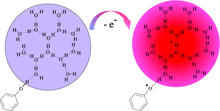Publication
683
J. Am. Chem. Soc., 133 (17), 6668-6674, 2011
DOI:10.1021/ja110935c
|
|
|
|
|
 |
Water (in water) as an intrinsically efficient proton acceptor in concerted proton electron transfers |
|
|
|
|
Julien Bonin, Cyrille Costentin, Cyril Louault, Marc Robert, and Jean-Michel Savéant
Laboratoire d’Electrochimie Moléculaire, UMR CNRS 7591, Université Paris Diderot, 15 rue Jean-Antoine de Baïf, 75205 Paris Cedex 13, France
The oxidation of PhOH in water by photochemically generated RuIII(bpy)3 is taken as prototypal example disclosing the special character of water, in the solvent water, as proton acceptor in concerted proton−electron transfer reactions. The variation of the rate constant with temperature and driving force, as well as the variation of the H/D kinetic isotope effect with temperature, allowed the determination of the reaction mechanism characterized by three intrinsic parameters, the reorganization energy, a pre-exponential factor measuring the vibronic coupling of electronic states at equilibrium distance, and a distance-sensitivity parameter. Analysis of these characteristics and comparison with a standard base, hydrogen phosphate, revealed that electron transfer is concerted with a Grotthus-type proton translocation, leading to a charge delocalized over a cluster involving several water molecules. A mechanism is thus uncovered that may help in understanding how protons could be transported along water chains over large distances in concert with electron transfer in biological systems. |

